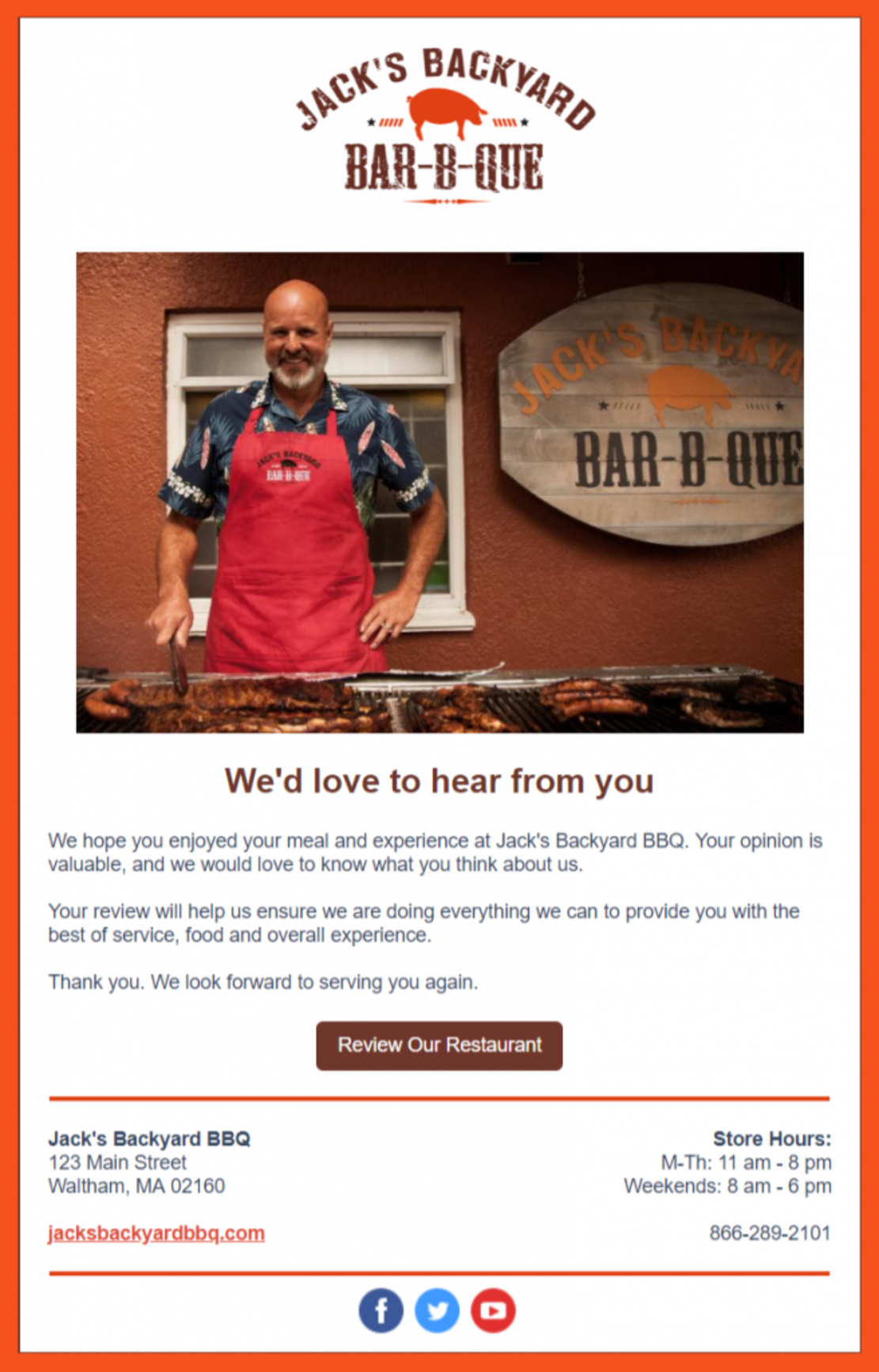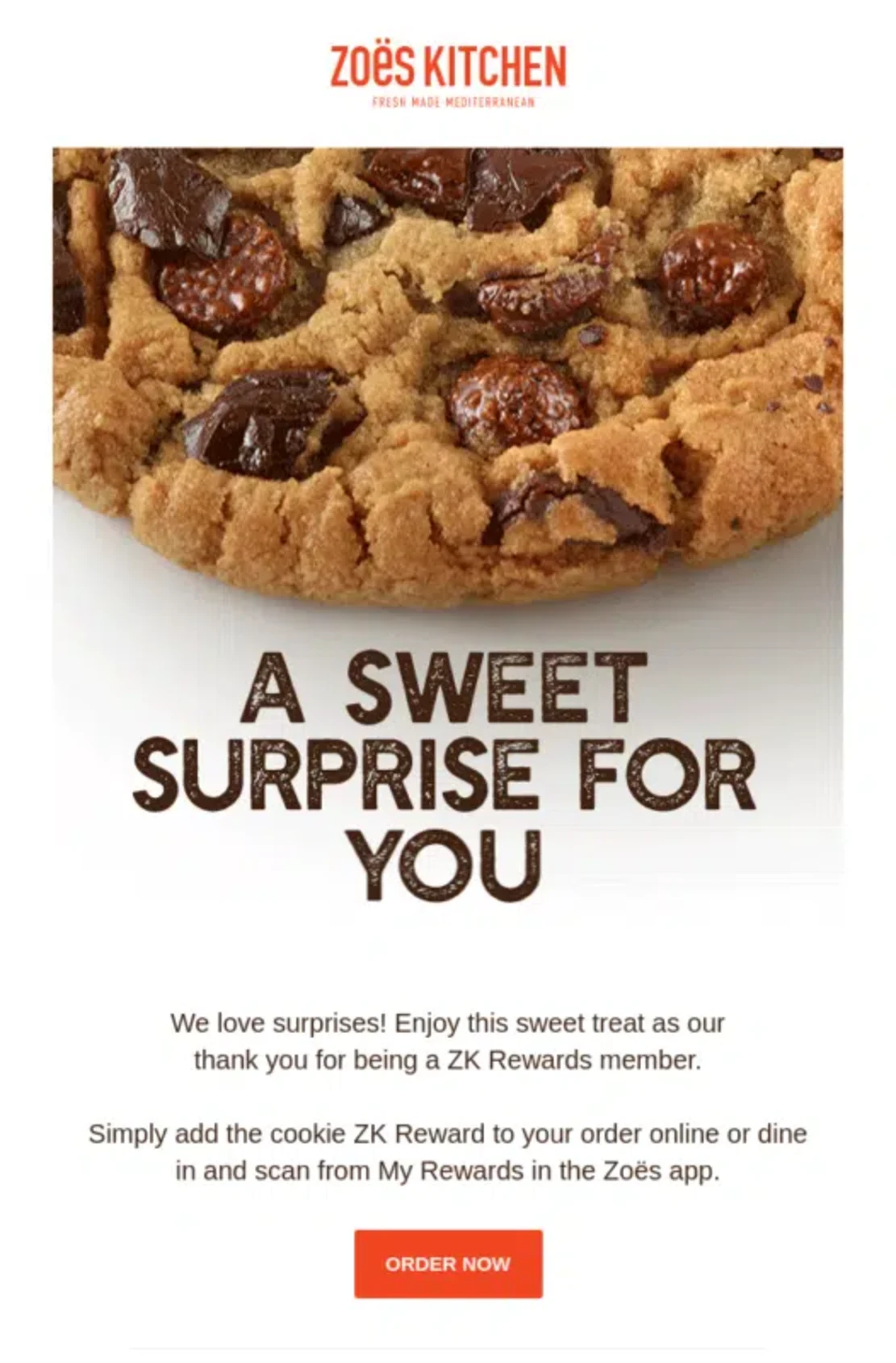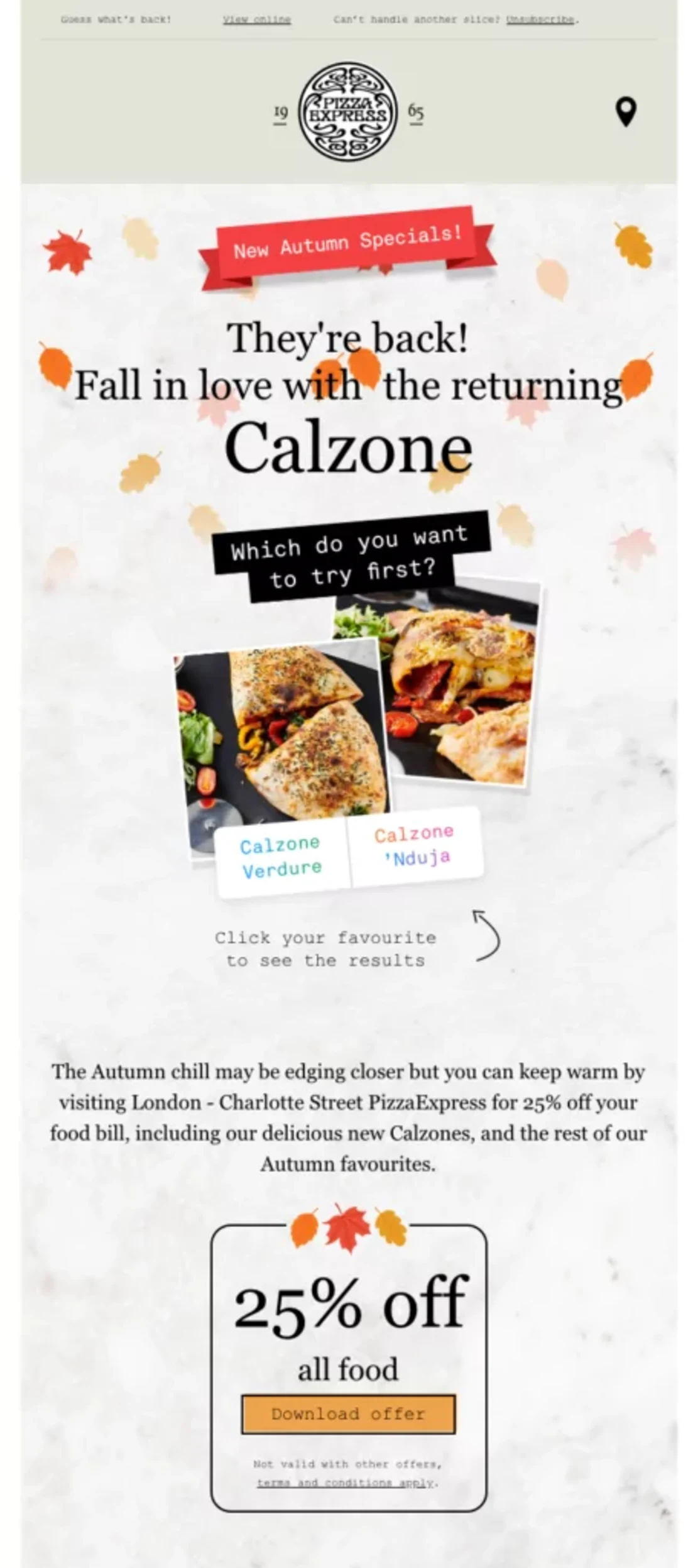Best Email Marketing Practices for Restaurants
You already know that.
Email marketing for restaurants is a super-popular digital strategy because it works. However, for many business owners, the idea of writing emails to their guests is everything but exciting.
Additionally, with all the duties and deadlines you might be dealing with to run your business, restaurant email marketing is at the bottom of your priority list.
While we can not push you to engage in email marketing, we can show you how to do it simply and effectively.That’s why in this article we collected everything you need to know about email marketing for restaurants.
We are going to show you the tips and best practices for making effective emails, which mistakes you should avoid, and how to set a solid email marketing strategy.
Last but not least, we will provide you with a ton of ideas and templates that you can replicate for your email marketing campaigns.
The case for email marketing for restaurants
Email marketing is one of the oldest yet most successful digital marketing strategies to win customers.
In fact, it is considered the most appropriate channel to receive communication from brands by customers of any age.
Email marketing has two main big advantages compared to other marketing strategies.
First, it is a direct channel of communication.
Contrary to social media like Facebook, you don’t need to please a platform to get the attention of your audience. You connect directly with them.
Second, you own the list.
Any email address you collect will be under your control and no one can take it from you. Just like an asset.
There’s virtually no industry where email marketing is not part of a marketing strategy.
You can use email marketing for your restaurant to nourish the relationship with your customers, promote any aspect of your business and, ultimately, drive more sales.
On average, for every dollar you spend on email marketing you get $36 back. That’s an outstanding ROI.
However, reaching those impressive results is not as straightforward and intuitive as it might sound.
You’ve got to first learn how to write email effectively and what type of communications your customers like.
Do you want to know more?
The rest of the article will provide you with tips for writing emails effectively and example of successful restaurant email marketing.
Email marketing tips for restaurants
This is counterintuitive to many small business owners.
Email marketing for restaurants should NOT convert immediately a reader into a guest.
A solid email marketing strategy for a restaurant aims to create an ongoing relationship with its customers. It keeps them engaged and up-to-date with the business.
If you adopt this outlook, then selling will be a natural consequence of your marketing effort.
The following is a breakdown of the do’s and dont’s for creating effective emails. Take notes of these email marketing tips for restaurants and use them within your campaigns.
Think of your ideal guest
This is a universal communication rule. Use the language, tone, and vibes that match your intended audience.
Email Subject
Your email is likely to compete with other emails for being opened. Therefore, you always have to think of a subject line that can’t be ignored.
Preheader
The preheader is the line that a subscriber sees just after the subject. Write something that adds to your subject line.
Use always your name
Use your brand name when sending emails. Recognizing the sender is proven to be the most important factor for opening an email.
Be authentic
Out of all these email marketing tips, this is the most important. Your emails will shape the perception your guests have about your brand. Therefore, be authentic and embody your business identity.
Less is more
Be sure not to bombard your guest’s inbox. Only write an email when you have something relevant to say.
Customization
Be sure to include the first name of the recipient somewhere in the email. This will increase the opening rate, avoid spam filters and the customer will feel like a personal conversation has started.
Images and video
It is known that humans process visuals 60000 times faster than text. Therefore, use evocative images and videos that engage with your subscribers.
Don’t overstress
Being good with email marketing might take a while. Allow yourself to make mistakes.
Schedule your email
Your audience might be particularly receptive during some hours/days. Try out sending emails at different moments of the week and find out when your customers are receptive.
Use CTA properly
Not all your emails have to include a Call to Action (CTA). However, when you want your reader to perform an action, ensure that the CTA stands out clearly.
Should you use email marketing software for your restaurant?
The short answer is YES.
Email marketing software for restaurants can save time and simplify the process of reaching out to customers.
There are a number of different software programs available, each with its own set of features. However, unless your email list is huge and you want to try complex email marketing strategies, the most important thing to look for in an email marketing service is how easy it is to use.
The software should be able to handle a large number of contacts and allow you to easily create and send newsletters and other promotional materials.
Restaurant Email Marketing examples
Let’s say it again.
Email marketing for restaurants is about building a relationship with your guests and keeping them in the loop.
If you constantly remind yourself of this, sales and reservations will be a consequence.
These are examples of email marketing for restaurants that stood the test of time. You can virtually replicate any of them.
- Offer vouchers and coupons
- Run a competition with prizes
- Highlight menu items and updates
- Announce Limited Time Offer
- Tell stories about your restaurant (your history, how you source ingredients, etc.)
- Promote special events
- Celebrate your customers’ birthdays (with a coupon)
- Share tips on meal/drink preparation
- Ask for feedback and reviews
You can start off with these ideas and you will be busy for a while. However, you can also try out new email marketing initiatives and see how they work with your subscribers.
At this point, you have a strategy for doing email marketing for your restaurant.
Now we are going to put all the pieces together by having a look at some examples of effective restaurant email marketing.
Restaurant email marketing templates
These are templates of email marketing for restaurants that work.
You can take inspiration from these emails and adapt them to your brand identity and restaurant vibe.
Let’s start:
1. Encourage reviews
Reviews are one of the most decisive elements when it comes to picking a local business.
According to BrightLocal, over 90% of consumers check reviews before choosing a local business.
In other words, getting positive reviews is a critical element of your business’ success.
You can leverage the power of email marketing to get reviews. After all, if they are on your list they should also like your place.
This is a great example of what we are talking about:
Jack’s Backyard BBQ

As you can see, it’s all about simplicity and genuineness.
What you see is a picture that incorporates the vibes of the brand plus a few lines to express gratitude. Last, is a CTA that asks for a review.
This is an example of email marketing for restaurants done like a pro.
You can simply adapt it to your restaurant and encourage a pleasant flow of reviews.
2. Offering coupons and vouchers
Vouchers, coupons, and discounts are always loved by loyal customers. This is one of the simplest ways to use email marketing for your restaurant.
Look at this example from a popular restaurant chain in Texas: Zoës Kitchen.

Few words straight to the point and a well-placed, captivating picture of one of their typical dish.
As you can see, this is not rocket science. Yet, this type of email will fill your venue.
Nonetheless, use it with care. If you continuously offer vouchers and coupons, the perceived value of your creation might be questioned.
3. An evergreen of email marketing for restaurants: Menu Updates
Your menu is like the Netflix dashboard.
People want to know if there’s something new.
Therefore, anytime you change or add new items, let your customers know.
At Sweetgreen they mastered this type of email.
Sweetgreen is a chain that mostly serves salads. Their menu changes following the seasonality of the ingredients.
Have a look at how they communicated their upcoming menu to their customers.

Their email balances colors, images, and font. It recreates the soft and genuine atmosphere of their venues.
Inside this frame, they insert all the new entries in their menu, providing a compelling reason (and a CTA) to order online or pay a visit.
This is a perfect example of restaurant email marketing properly done!
4. Play a game
The format of the emails above is simple and straightforward.
Let’s see something more creative and highly engaging.
Look at what Chick-fil-A did.

They designed this email as an interactive game to promote their seasonal menu.
Additionally, their users had fun sorting the game (engagement) and they got thousands of interactions on their social media (popularity)
As this email proves, interactive content overdeliver when properly crafted. You might think of something similar for your next email!
5. Email marketing for restaurants 101: the welcome email
The first email you send is one of the most important you will ever send.
8 out of 10 people open a welcome email and it set the tone for all your further communications.
Thus, your first email has to be your best welcome.
Be sure to include all the unique elements and most appreciated aspects of your restaurant.
The welcome email of Yoko restaurant fully encapsulates this concept.

They created a simple yet effective collage of their best dishes. One picture that the vibes and the quality of their kitchen.
Email marketing for restaurants starts with a welcome email. Be sure to make a remarkable piece of content that enchants your reader.
6. Promote and remind events
Promoting your event is probably the most appropriate format of email marketing for restaurants.
Your customers are interested in knowing what your venue offers.
If you run regular events (Live Music, karaoke, game nights, etc.) you can send emails as reminders.
Instead, if you run special events like Halloween, Christmas, or New Year’s, then you can use email marketing for promotion and pre-sales of tickets.

Special events promotion is ultimately a sales pitch.
Use a slick graphic, describe the event and explain why it can not be missed. Obviously, don’t forget to provide all the information for booking.
You can also push reservations by adding exclusivity and scarcity to your proposal [e.g. only 100 seats available or booking only lasts 48hrs].
7. Email marketing for restaurants to teach and Inspire
What if you teach your audience how to prepare a dish or a drink?
This type of email marketing campaign works particularly well for restaurants.
They show your knowledge in the field, how you select ingredients and the mastery of the chefs. Is a fantastic way to indirectly promote your expertise.
Embedding a video in your email is the best way for doing this.
Prepare a step-by-step tutorial on how to make a dish or a drink. If your chef is also a showman, even better. Anything that is authentic is welcome.
This video provides you with an excellent example of what we are talking about.
Remember: on the other side of the inbox there is not a Masterchef judge.
Keep it easy, actionable, and engaging.
8. The best dishes
Email marketing can be used to leverage your best creation and bring guests over.
This type of email marketing strategy focuses on one popular item on your menu.
An example of this strategy is provided by Pizza express.
They use email marketing to promote one of their most popular meal: The Calzone.

You can look at this sample, tweak it and adapt it to your creations. Simple and effective.
Should you use email marketing for your restaurant?
Restaurant email marketing is a fantastic way to fill your venue with guests and grow loyalty toward your business. This article showed you how you can do it effectively for your restaurant.
It might take time but is worth the effort.
If you want to increase the result of your marketing effort and provide a smoothless WiFi experience to your guests, check out Beambox.
Beambox is an all-in-one solution for WiFi marketing that helps you connect with your customers, grow your email list and social media pages, and increase the profitability of your business.
Have a look at our solutions for small business owners.
Get Started With Free WiFi Marketing
Beambox helps businesses like yours grow with data capture, marketing automation and reputation management.
Sign up for 30 days free


